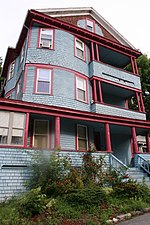Woodford Street Historic District
Colonial Revival architecture in MassachusettsHistoric districts in Worcester, MassachusettsHistoric districts on the National Register of Historic Places in MassachusettsHouses completed in 1926NRHP infobox with nocat ... and 1 more
National Register of Historic Places in Worcester, Massachusetts

The Woodford Street Historic District includes a cohesive collection of five triple decker houses at 35–39 and 38–40 Woodford Street in Worcester, Massachusetts. Built about 1926, they are a well-preserved group of Colonial Revival houses built in the last phase of the city's triple decker development. The district was listed on the National Register of Historic Places in 1990.
Excerpt from the Wikipedia article Woodford Street Historic District (License: CC BY-SA 3.0, Authors, Images).Woodford Street Historic District
Woodford Street, Worcester
Geographical coordinates (GPS) Address Nearby Places Show on map
Geographical coordinates (GPS)
| Latitude | Longitude |
|---|---|
| N 42.243333333333 ° | E -71.790555555556 ° |
Address
Woodford Street 37
01655 Worcester
Massachusetts, United States
Open on Google Maps











